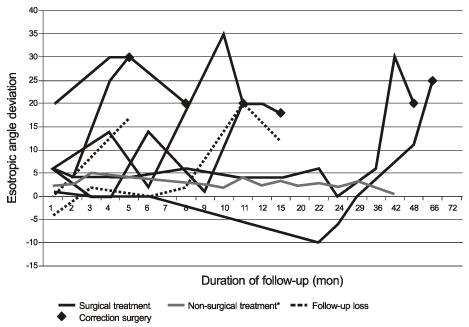J Korean Ophthalmol Soc.
2012 Sep;53(9):1318-1323. 10.3341/jkos.2012.53.9.1318.
Consecutive Esotropia after Lateral Rectus Muscle Recession for Intermittent Exotropia
- Affiliations
-
- 1Department of Ophthalmology, Hallym University College of Medicine, Anyang, Korea. kimleejy@hallym.or.kr
- KMID: 2216086
- DOI: http://doi.org/10.3341/jkos.2012.53.9.1318
Abstract
- PURPOSE
To evaluate the progress and outcome of consecutive esotropia after surgery for intermittent exotropia.
METHODS
The authors investigated the risk factors, changes in the angle of esodeviation and treatment outcome in consecutive esotropia after lateral rectus muscle recession for intermittent exotropia in 196 patients.
RESULTS
Consecutive esotropia occurred in 25 patients (12.8%). The patients underwent more frequent combined muscle surgeries on vertical and oblique muscles (p = 0.001) and had a greater amount of immediate postoperative overcorrection than subjects without consecutive esotropia. There was no significant difference with the incidence of overcorrection greater than 17 PD between the 2 groups with and without consecutive esotropia. There was no difference with the immediate postoperative overcorrection between the 6 cases that required surgery for their consecutive esotropia and the cases that recovered from their consecutive esotropia with conservative treatment. The former showed increasing esodeviation and maximum angle at average postoperative month 29.5. In the latter, esodeviation tended to decrease and showed maximum angle at average postoperative month 4.3. Finally, esotropia disappeared and good stereoacuity was obtained in both cases.
CONCLUSIONS
Although subjects with consecutive esotropia had a greater immediate postoperative overcorrection than subjects without consecutive esotropia, the progress and outcome of consecutive esotropia following the initial overcorrection were not predictable. Consecutive esotropia after surgery for intermittent exotropia showed good overall outcome and well-preserved stereoacuity after treatment.
Figure
Cited by 2 articles
-
Surgical Outcomes of Modified Medial Rectus Resections in Recurrent Intermittent Exotropia
Kwang Hyun Kim, Joo Yeon Lee
J Korean Ophthalmol Soc. 2019;60(11):1098-1104. doi: 10.3341/jkos.2019.60.11.1098.Characteristics of Patients Who Are Not Responsive to Alternate Patching for Overcorrected Intermittent Exotropia
Jung Yup Kim, Hae Rang Kim, Soo Jung Lee
Korean J Ophthalmol. 2018;32(4):319-327. doi: 10.3341/kjo.2017.0086.
Reference
-
1. Clarke WN, Noel LP. Surgical results in intermittent exotropia. Can J Ophthalmol. 1981. 16:66–69.2. Raab EL, Parks MM. Recession of the lateral recti. Early and late postoperative alignments. Arch Ophthalmol. 1969. 82:203–208.3. Scott WE, Keech R, Mash AJ. The postoperative results and stability of exodeviations. Arch Ophthalmol. 1981. 99:1814–1818.4. Hardesty HH, Boynton JR, Keenan JP. Treatment of intermittent exotropia. Arch Ophthalmol. 1978. 96:268–274.5. Burian HM, Spivey BE. The surgical management of exodeviations. Am J Ophthalmol. 1965. 59:603–620.6. Kim HS, Suh YW, Kim SH, Cho YA. Consecutive esotropia in intermittent exotropia patients with immediate postoperative overcorrection more than 17 prism diopters. Korean J Ophthalmol. 2007. 21:155–158.7. Shin YJ, Chang BL. The clinical outcome of the consecutive esotropia after surgical correction. J Korean Ophthalmol Soc. 2003. 44:2085–2090.8. Von Noorden GK. Binocular Vision and Ocular Motility : Theory and Management of Strabismus. 2002. 6th ed. St. Louis: MO Mosby;371–372.9. Moore S. The prognostic value of lateral gaze measurements in intermittent exotropia. Am Orthopt J. 1969. 19:69–71.10. Lew H, Lee JB, Han SH, Park HS. Clinical evaluation on the consecutive esotropia after exotropia surgery. J Korean Ophthalmol Soc. 1999. 40:3482–3490.11. Kim JH, Hwang JM. Initial overcorrection of 20 delta or more after surgery of exotropia. J Korean Ophthalmol Soc. 2003. 44:121–127.12. Parks MM, Mirchell P. Duane TD, Jaeger EA, editors. Concomitant exodeviations. Clinical Ophthalmology. 1988. v. 1. Philadelphia: JB Lippincott;1.13. Cho YA, Lee JK. Early surgery before 4 years of age in intermittent exotropia. J Korean Ophthalmol Soc. 2004. 45:620–625.14. Richard JM, Parks MM. Intermittent exotropia. Surgical results in different age groups. Ophthalmology. 1983. 90:1172–1177.15. Dunlap EA. Manley DR, editor. Overcorrection in exotropia surgery. Symposium on Horizontal Ocular Deviations. 1971. St. Louis: CV Mosby;183.16. Nusz KJ, Mohney BG, Diehl NN. Female predominance in intermittent exotropia. Am J Ophthalmol. 2005. 140:546–547.17. Korean Association for Pediatric Ophthalmology and Strabismus. Exodeviations. Current Concepts in Strabismus. 2008. 2nd ed. Seoul: Naewaehaksool;214–232.18. Rah SH, Jun HS, Kim SH. An epidemiologic survey of strabismus among school-children in Korea. J Korean Ophthalmol Soc. 1997. 38:2195–2199.19. Gregersen E. The polymorphous exo patient. Analysis of 231 successive cases. Acta Ophthalmol (Copenh). 1969. 47:579–590.
- Full Text Links
- Actions
-
Cited
- CITED
-
- Close
- Share
- Similar articles
-
- Consecutive Esotropia after Surgical Correction of Intermittent Exotropia
- The Clinical Analysis of Surgical Methods in Intermittent Exotropia
- Clinical Evaluation on the Consecutive Esotropia after Exotropia Surgery
- The Effect of Advancement of the Lateral Rectus Muscle on the Consecutive Esotropia
- The Effect of Lateral Rectus Muscle Advancement in Consecutive Esotropia After Bilateral Rectus Muscle Recession



